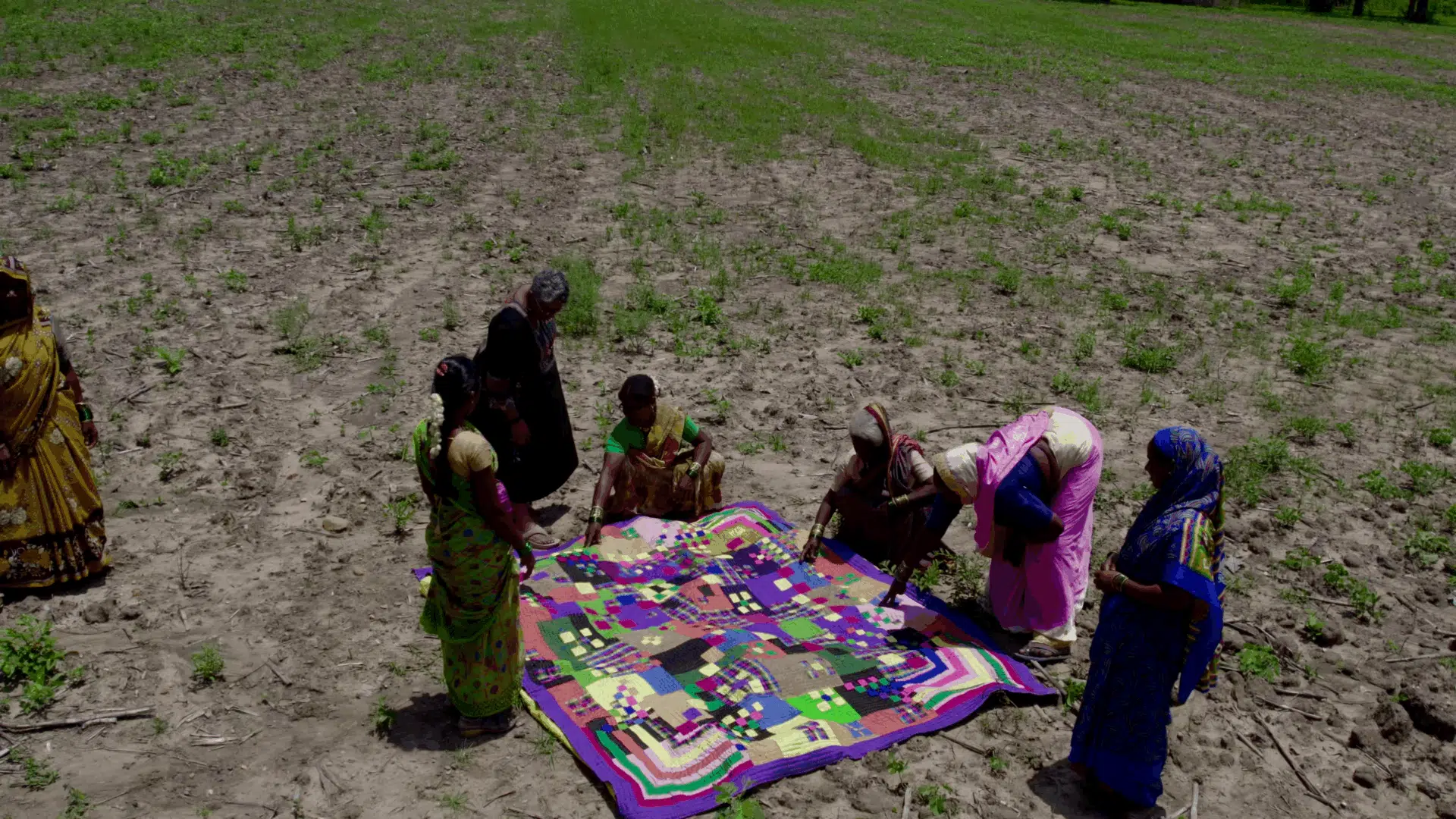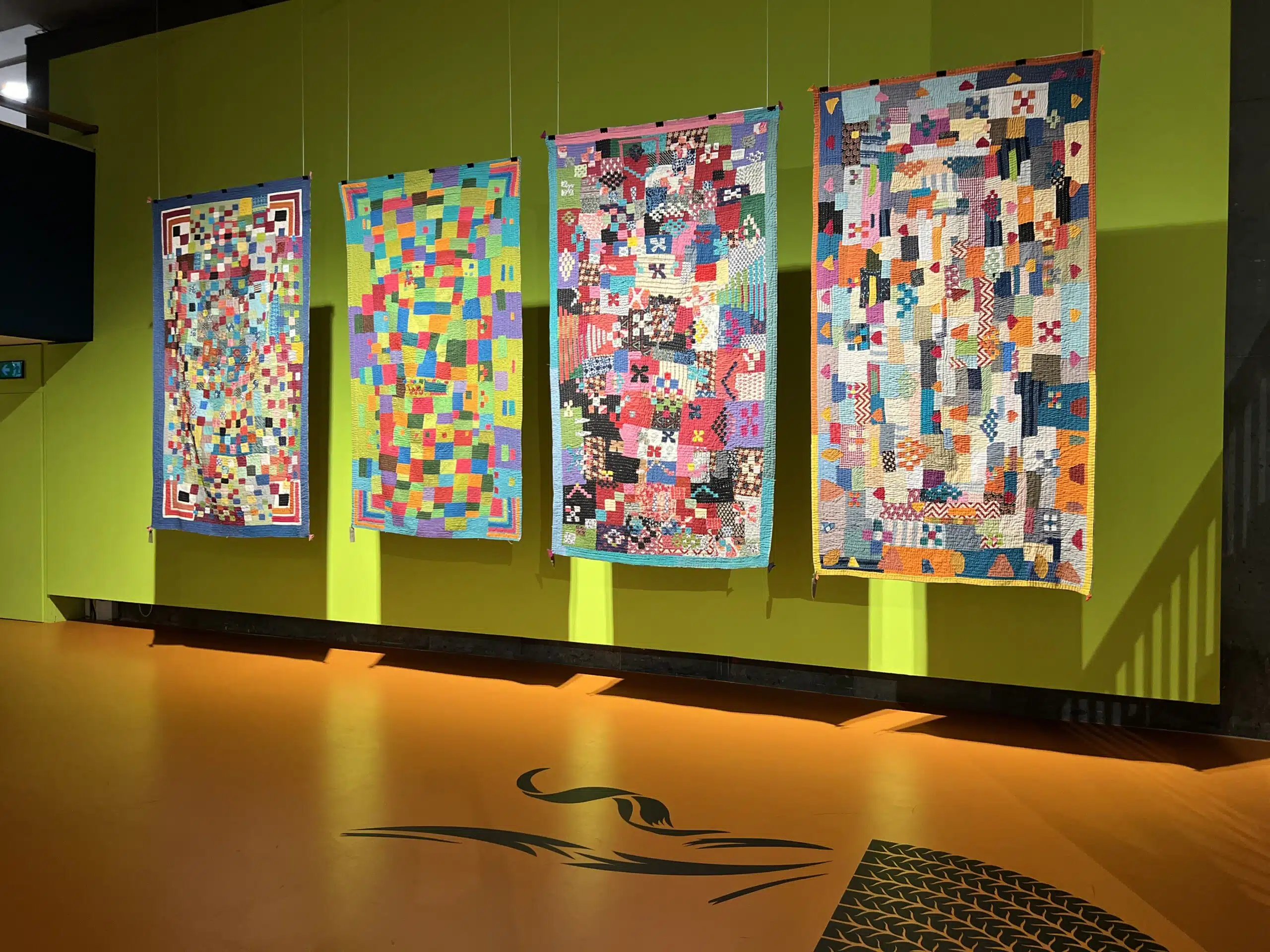For over fifteen years, Reddy has collaborated with the Siddis in Uttara Kannada district in the south Indian state of Karnataka to make kavands or quilts stitched from worn clothes and fabric that carry familial memory, reminiscence and remembrance in an attempt to reimagine authorship. Descendants of Bantu-speaking people from East Africa, the Siddi ancestors were brought to India largely as slaves by Arabs as early as the 7th century. Later the Portuguese and British also contributed significantly to the migration of Siddis to India, and when slavery was abolished in the 18th and 19th centuries, Siddis sought refuge in the country’s dense forests, fearing recapture. Though they’ve lived in India for over four centuries, the Siddis remain largely forgotten.
In her work, Reddy rejects hierarchies between artist and artisan and treats community, material, nature and process as equal collaborators. Her practice centres storytelling, environmental care, and cultural equity, and challenges predominant narratives that frame the Siddis as outsiders. The quilts that emerge through this collaboration are more than objects of warmth – they are acts of kinship, collective narratives and blessings from a community that has had to navigate belonging, identity and the idea of ‘home’ for generations.
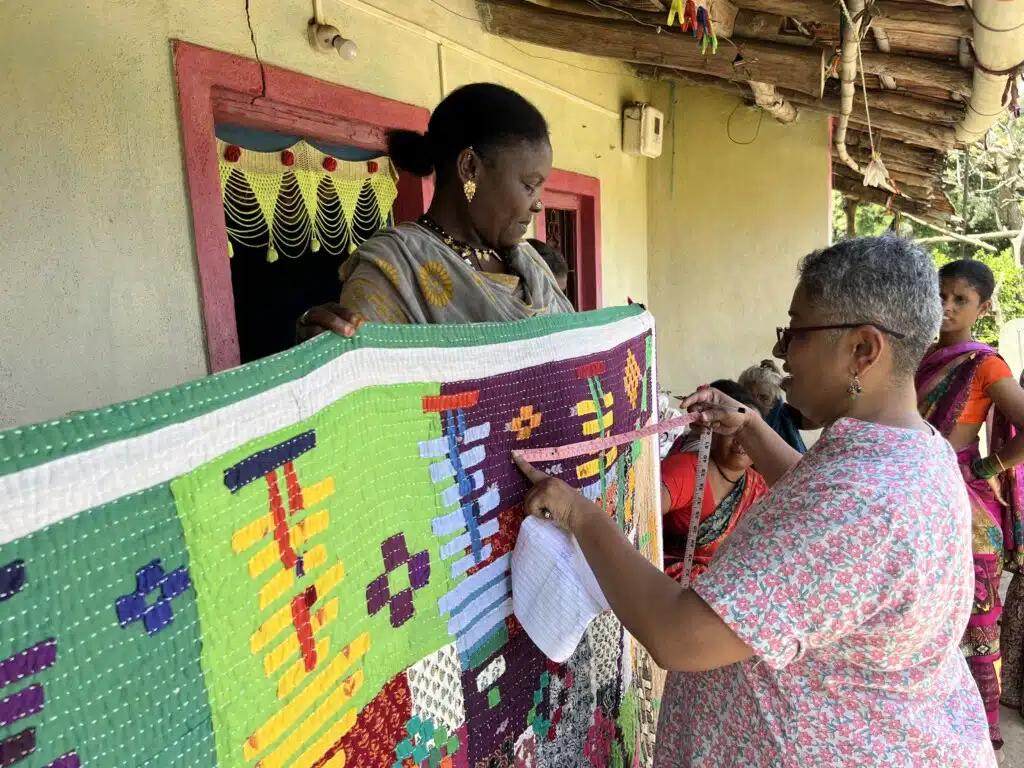
We sat down with Anitha Reddy to trace the contours of her community-centered artistic practice and her work with the Siddi women.
Could you share the story of how this collaboration with the Siddi women began? How did you find your way into this community and their quilt-making tradition?
My first encounter with the Siddi community was many years ago, through a dear friend of mine—a theatre artist. He’s no longer with us, but at the time, he was deeply involved in working with Siddi children, creating spaces for them to explore drama and storytelling.
I had gone there to photograph some of his work and stayed with a Siddi family. What began as a visit soon turned into a quiet immersion. I remember noticing the women who came by to drop off their children for the theatre sessions. They intrigued me—their strength, their silence, their presence. I found myself wondering: Who these women were, and if there was any way to work with them?
By then, I had already fallen in love with the place — the forest – home to the Great Hornbill, the Lion-tailed Macaque and the Malabar pit viper, the diverse tribal communities that relied on the forest for their livelihood – the relationship they shared with this sacred space, including the Halakki Vokkaligas, Kunbi and the Goulis, and the region’s rich linguistic traditions. Apart from forest produce, people here also work as laborers in nearby farms and engage in subsistence farming of their own. There is little to no time for leisure and when the women find time, between everything else, they gather old, worn out, used fabric from family members, neighbours and small local tailoring shops to stitch into quilts – these quilts or kavands are markers of time in a Siddi household – signifying key life events – from the birth of a child or grandchild to the wedding of a daughter, son, niece or nephew, it holds moments of joy and transition, wisdom of the ancestors and blessings of abundance.
On one of my visits to a household, I recognized a piece of fabric that was stitched into a quilt – it was an old piece of clothing that I had given them from an earlier visit. That moment opened up a portal for our worlds to come together and laid the foundation for trust, sharing and solidarity – something that I continue to build on even after all these years. And from that point on, I knew I wanted to walk alongside the women—to listen, to learn and to co-create.
How did your background in the arts prepare you for this way of working?
It didn’t. The process of working with the Siddi women has been as much about unlearning as it has been about learning. Coming from an academic background in art history, and having worked with various artist groups, I had internalised certain frameworks about how art is made, valued and circulated—especially in the context of community or collective practices. There’s often a pre-defined structure when a designer or artist enters a community, learns a technique or idea and repackages it into a product or a concept under their own authorship. This was something I had to interrogate deeply within myself.
When I first engaged with the Siddi women, I realised that the quilts they made were already complete in their own right — both as functional objects and as deeply expressive artefacts. They didn’t need to be ‘developed’ and the idea that I should add value to their work by transforming it into something ‘marketable’ was, in fact, rooted in my own training and assumptions. That was my need, not theirs.
Each quilt is an archive of family life, stitched by women who capture a piece of their world with what is readily available. I had to unlearn the narrow view that this was simply recycling or ‘craft born of necessity.’ I had to see it for what it was: a deeply personal and creative engagement during their leisure time. This unlearning also led to me re-examining what constitutes work and to be a professional engaging with communities. In urban, institutional settings, being a professional comes with certain norms but in the field, especially when engaging with a community that has been historically marginalized, discriminated against and silenced, those norms fall short. I had to learn a different way of working: one based on trust, patience, presence, reciprocity and deep listening.
This came with personal sacrifices too. By choosing to stand with a community placed at the lowest rung of the caste system—who also looked visibly different — I was treated differently as well by other local communities, people from the village who constantly questioned my choices, and this included the broader art and design fraternity. The assumption was that as an artist or designer one had to claim authorship for the work / vision that one did / executed with the community, who were often seen as fabricators of the work and not co-authors. So, when I refused to separate the maker from the concept and insisted on presenting their work as their work, it disrupted things.
Bastin, a Siddi artist, sings and dances while stitching — a glimpse into everyday creative life.
Photo: Anitha Reddy and the artists
What are the quilts themselves made of, and what meanings do they carry? Could you speak about the kinds of stories, symbols, or motifs that appear in these quilts? How does daily life and memory shape the form?
The kavands are stitched using old clothes sourced within the family; bits of sarees, shirts and blouses — garments once worn by loved ones. Each scrap has a story, a season, the memory of a person associated with it, and sewing them together becomes an act of gathering, (re)collection and remembrance for the women.
In many families, women are forbidden from creating work for others — so kaudis are made for the home, passed down like heirlooms. The process itself remains largely undocumented, practiced in domestic spaces with each quilter bringing her own visual language to the quilt making-process some intuitive, others geometric and precise.
I have worked with women who stitch maps of their village—homes, trees, ponds, children—into a radiant, unreplicable design, and have witnessed mother and daughter duos, both quilters, living in the same household, with very different style—one spontaneous, the other symmetrical, as their way of reflecting inter-generational dialogue.
Recurring motifs include tikeli squares, temple shapes, and corner flames in various combinations. Since the women do not work with any template, they are constantly improvising on their designs through conversation, discovery, and play. Some quilters work alone, while others work in groups, both reflecting on their everyday lives and collective memory.
One recurring motif in their work is a triangular form that appears in various shapes and carries different meanings. Initially, I had interpreted this to mean and symbolise a stylized version of South Indian temple Gopuram towers. When I asked them, they confirmed it was indeed a Gopuram. But what I had visualised was a grand, towering structure – typical of temple architecture in South India, however during a visit —I noticed small, pointed local shrines scattered throughout the landscape. Shaped like a modest stepped pyramid and barely four feet tall – these shapes were in fact what the women were referring to. That’s when I truly understood: their imagery draws from their everyday visual world rather than monumental architecture.
In another instance, Rajmani, a woman I have worked with for a long time, had made a quilt with the word ‘TIT’ stitched on it. From my interactions with her, I knew she wasn’t literate, so I was curious about her reference and upon further investigation, I understood that she did not recognize the letters as a word but that she was responding to the shapes, adding that the letters T-I-T came from a Titan-branded fertilizer sack that she used as a pillowcase — absorbed into her visual memory, it was only a matter of time before it ended up in her work.
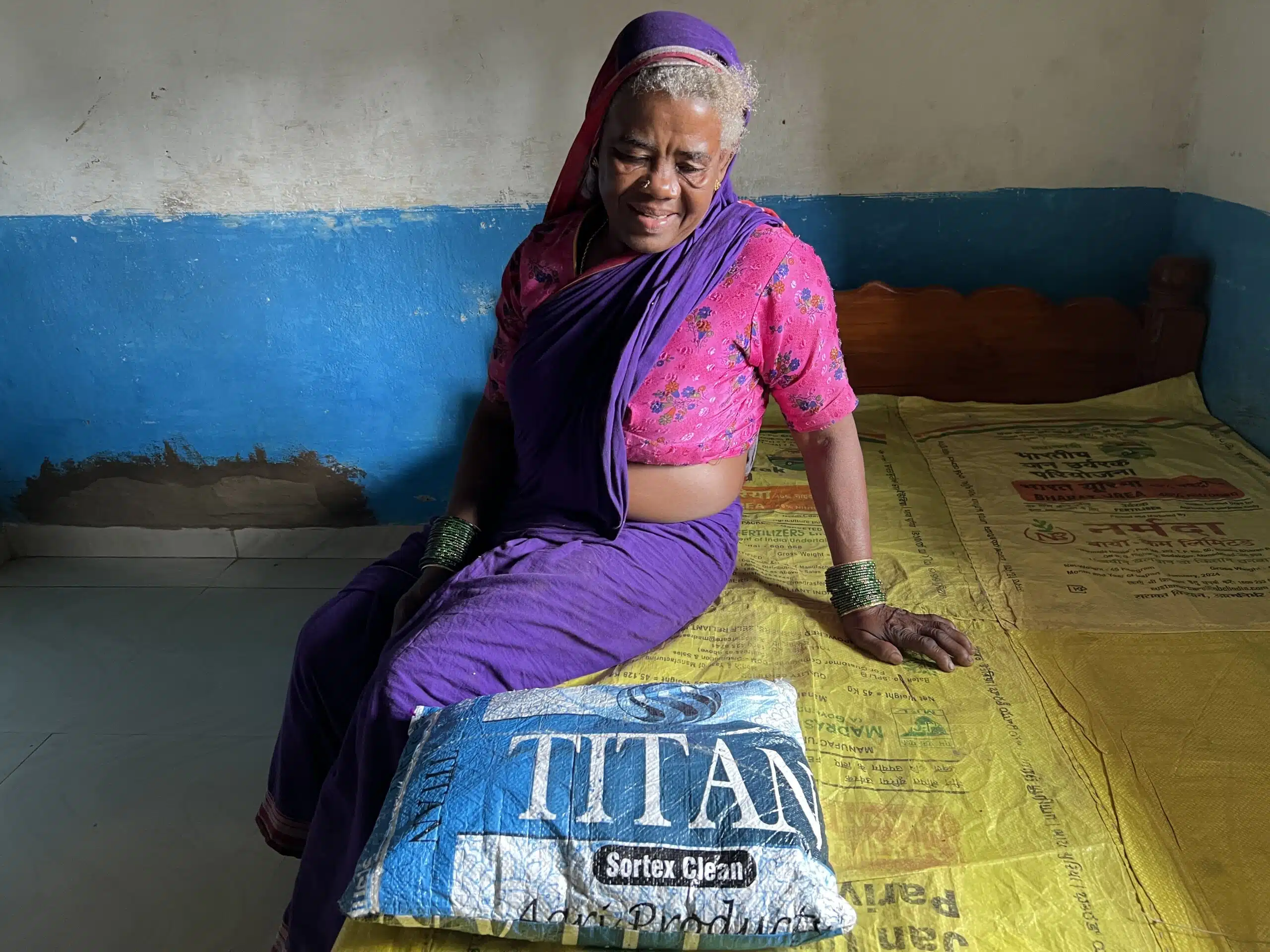
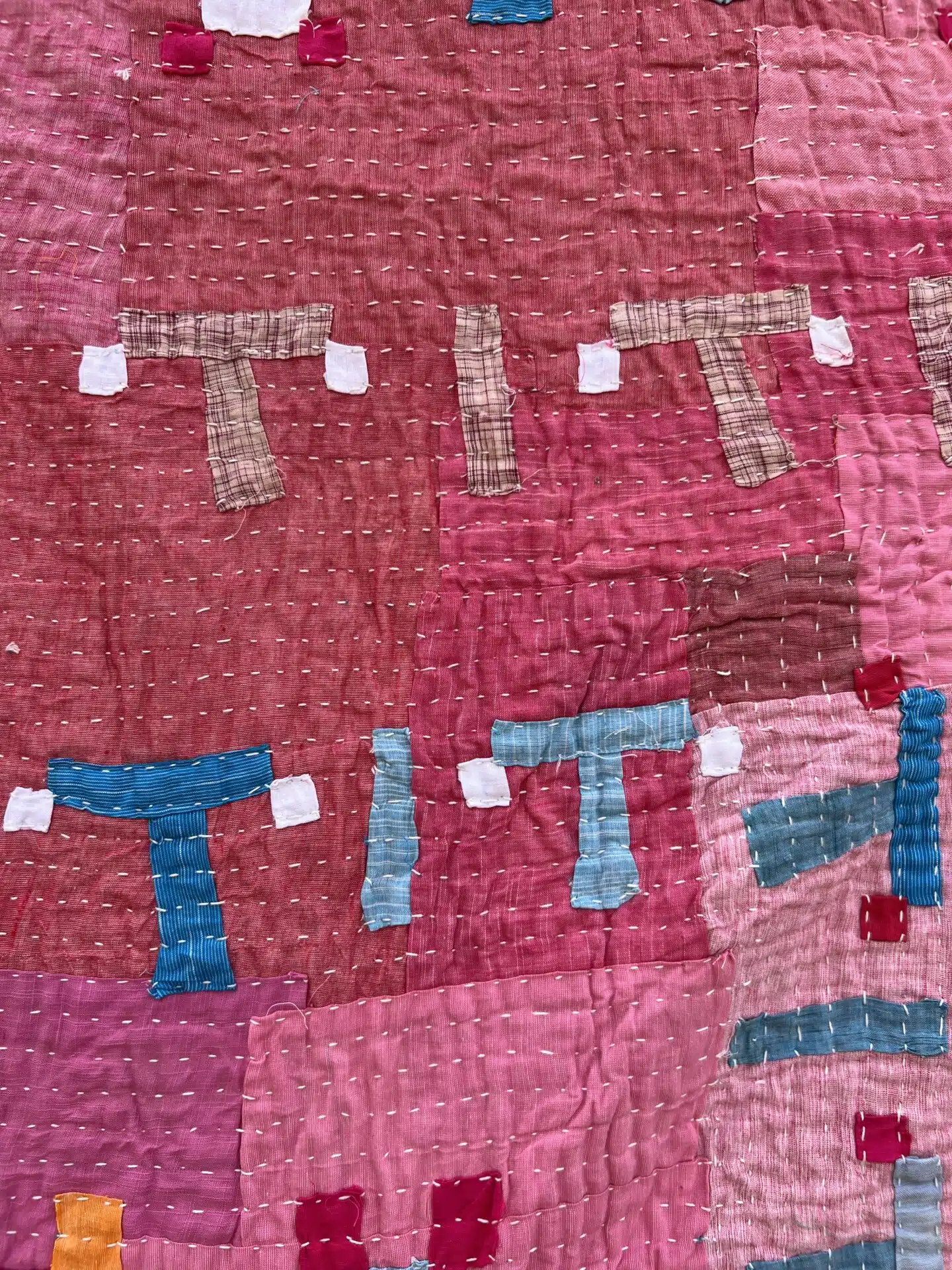
Like Rajmani, there are individual voices that shine through even in this collective engagement – Bastin’s delicate embroidery patterns, Saidamabi’s rebellious abstractions, and Hazru’s thoughtful compositions, which included a quilt she had made to welcome a newborn, featuring a crab, surrounded by dogs and girls at play – a metaphor, she said, for protection and joy.
In another instance, Basobi, who works as a cook and cleaner at a local anganwadi school stitched multiple Indian flags onto her quilt — something she had seen during Independence Day and Republic Day celebrations at the school as a way of holding onto that moment of pride and remembrance.
Many quilts end with the women sewing a grain of rice, a coin, or a food item into the final patch—a silent blessing for a full belly, a fertile womb, and a prosperous life. These symbolic gestures are rarely spoken aloud, but they carry deep meaning.
Being a community-based creative practitioner in this context has meant finding ways to build a vocabulary together, and inviting the world, on our terms, to thoughtfully-engage with the work. For a recent commission we did at the Bengaluru office of Australian-American software company, Atlassian, I mapped the city, while the women added abstract shapes. Most had never seen a map—and Bengaluru wasn’t part of their lived world. Yet their contribution revealed how identity, place, and movement could be reimagined through their own lens. It became a fascinating collaboration, with at least fifteen quilters working on the same panel.
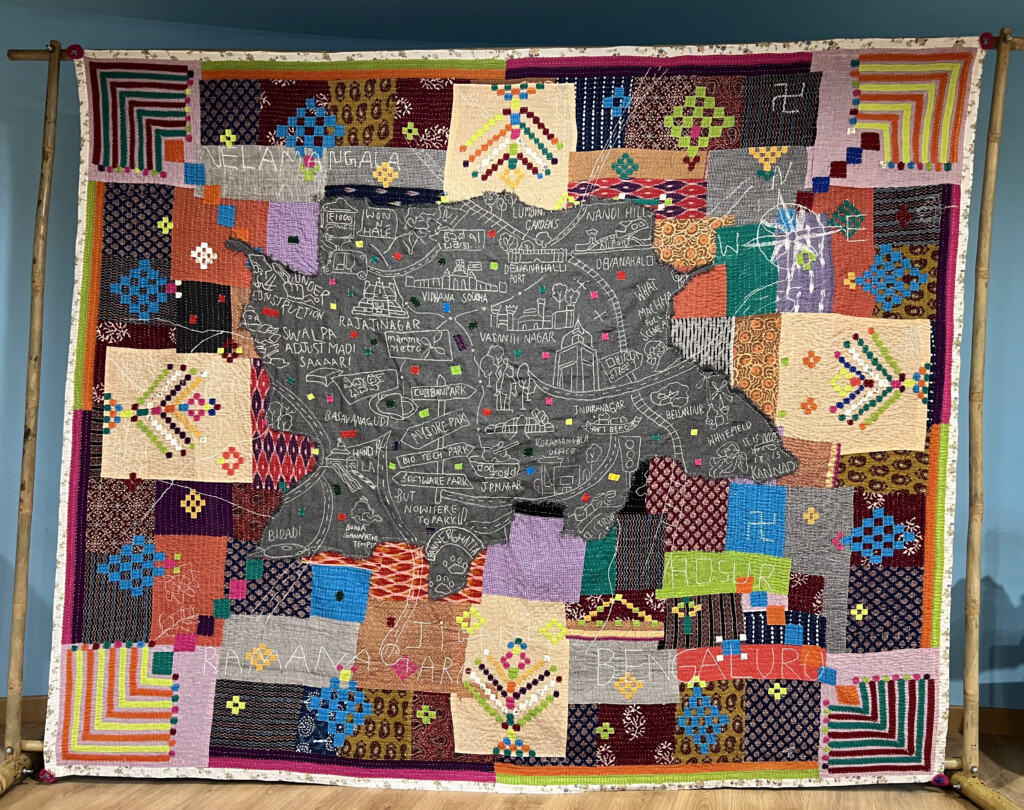
To hold a Siddi kaudi is to hold their entire world, in solidarity, in kinship and in recognition of a life that may not be immediately visible to us, but exists nonetheless, and the more we engage with the women and their work, we understand their collective ways of life, expression and resilience.
How did trust begin to form in the community? What did it take for them to see you not as an outsider, but as a collaborator?
Building trust with any community takes time. With the Siddi community that has endured centuries of marginalisation, displacement and systemic invisibility added a whole new layer of complexity to the process. The Siddis history of slavery and exclusion, along with ongoing struggles for land, recognition, and identity, determines to a great extent how they interact with anyone who arrives from the ‘outside.’
Even our Constitution places them in a generic Scheduled Tribe (ST) category—despite their distinct African-Indian heritage—because we don’t have a category for a displaced, foreign-origin, enslaved community. That erasure has deep consequences. So, when I began asking questions about their lives, their art, their materials, they were wary: Who are you to ask? Why now? Will this finally be used against us? So, when I first entered their space, I realised that this would mean patience, presence and consistency on my part. As a result I spent most of my time with them in the beginning just listening, observing and staying. I lived in their villages sharing their daily routine, their food, their festivals and rituals. This act of being physically and emotionally present was the first step. Trust, in this context, came not from words, but from consistency — of showing up, again and again.
Initially, there were many questions. “Why does this woman want to speak with us? Make a quilt with us?” “Why does she care about our old clothes?” These questions weren’t misplaced. Quilting, for many of them, is governed by patriarchal rules — it is meant to be done for one’s family, using the family’s old clothes. Making a quilt for an outsider, especially one who doesn’t ‘belong’ to the region, was unfamiliar and even threatening. But over time, they saw that I wasn’t trying to ‘improve’,‘teach’ them, or repackage their work into some exoticized artifact. I was there to walk beside them—to learn from them, share and co-create.
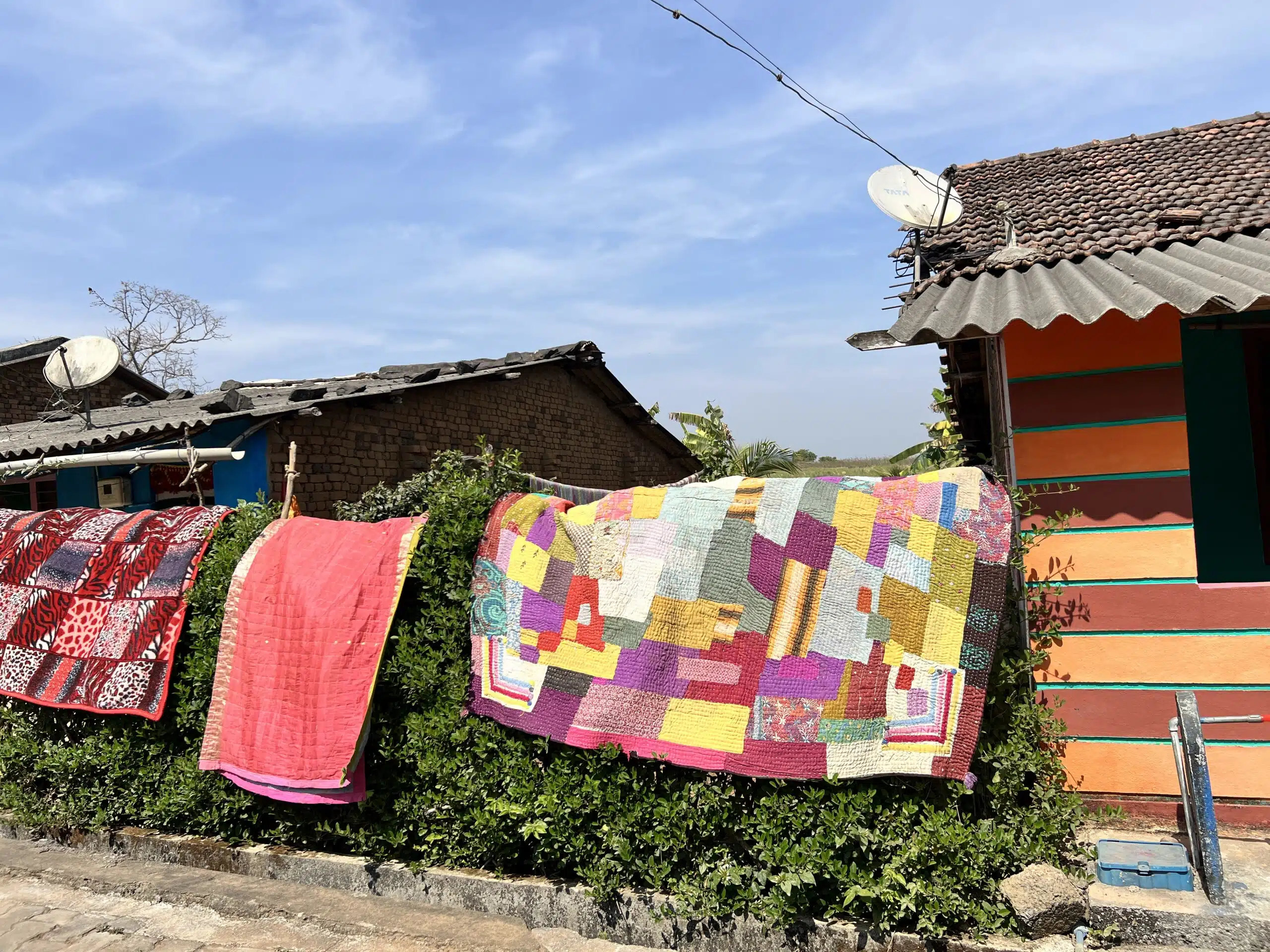
My visits across villages, my continued presence over months and years, helped reassure them that I wasn’t just passing through and that I would return. Still, trust wasn’t just about me and them—it also had to be navigated within the community itself. There are internal dynamics, frictions and politics among the women. Part of nurturing trust has meant acknowledging those tensions and mediating with care—never taking sides, never asserting control but holding space for everyone’s voice and emotions.
For a community whose movement is limited to the 50-kilometers-radius around their villages – it is a testament to our relationship that these women have started accompanying me to project sites outside their district. More recently, three women traveled with me to Jodhpur for an art residency and this I think is testament to the relationship we have built over the years – one based on mutual respect and camaraderie.
And every time I return, I understand that this is not something one takes for granted and is something that needs constant work — building constantly through reassurance and reciprocity.
You’ve spoken before about how your workshops have shifted. What does making together actually look like now?
The notion of a ‘workshop’ or ‘training’ in a conventional sense simply does not apply in this context. From the very beginning, I learned that rigid schedules or fixed outcomes were unrealistic. Instead, what was essential was my capacity to adapt, alter and reimagine for myself what this engagement would be. Over the years, I have found ways to align my schedule with theirs. Each visit begins with a theme or intention, but it’s never guaranteed that this will unfold as planned due to ongoing demands and unpredictability of their daily lives.
In the early days, I approached these sessions with a design-solution mindset—carrying tools like measuring tapes, templates and structured exercises. But I quickly realized that this approach didn’t resonate with the women. Mobilizing them required significant effort; some traveled from distant villages, leaving behind work and home responsibilities. Hosting a workshop wasn’t just about time and skill-sharing—it also meant ensuring everyone was fed and that responsibility often fell on me and the household where the session was held. The physical and logistical demands of cooking for 20 people, arranging transportation in remote areas, were immense. These early learnings prompted a shift in methodology. Instead of asking them to come to one place, I began traveling to their villages. As a result, I noticed a shift in how they responded during the sessions. This shift gave them a chance to host me, something that was rooted in their culture. I would eat lunch in a different home everyday and engage with the women of the household through informal and intimate exchanges. Over time, the workshops evolved from centralized, structured gatherings to more fluid, embedded nomadic engagements grounded in curiosities about one another, and the desire to host.
The tools I brought along to these engagements also changed, for instance, the measuring tape became irrelevant. Their sense of proportion and design didn’t align with standardized units.
Instead, what emerged was an intuitive, aesthetic logic — shaped by the reuse of old fabrics in varied sizes and shapes.
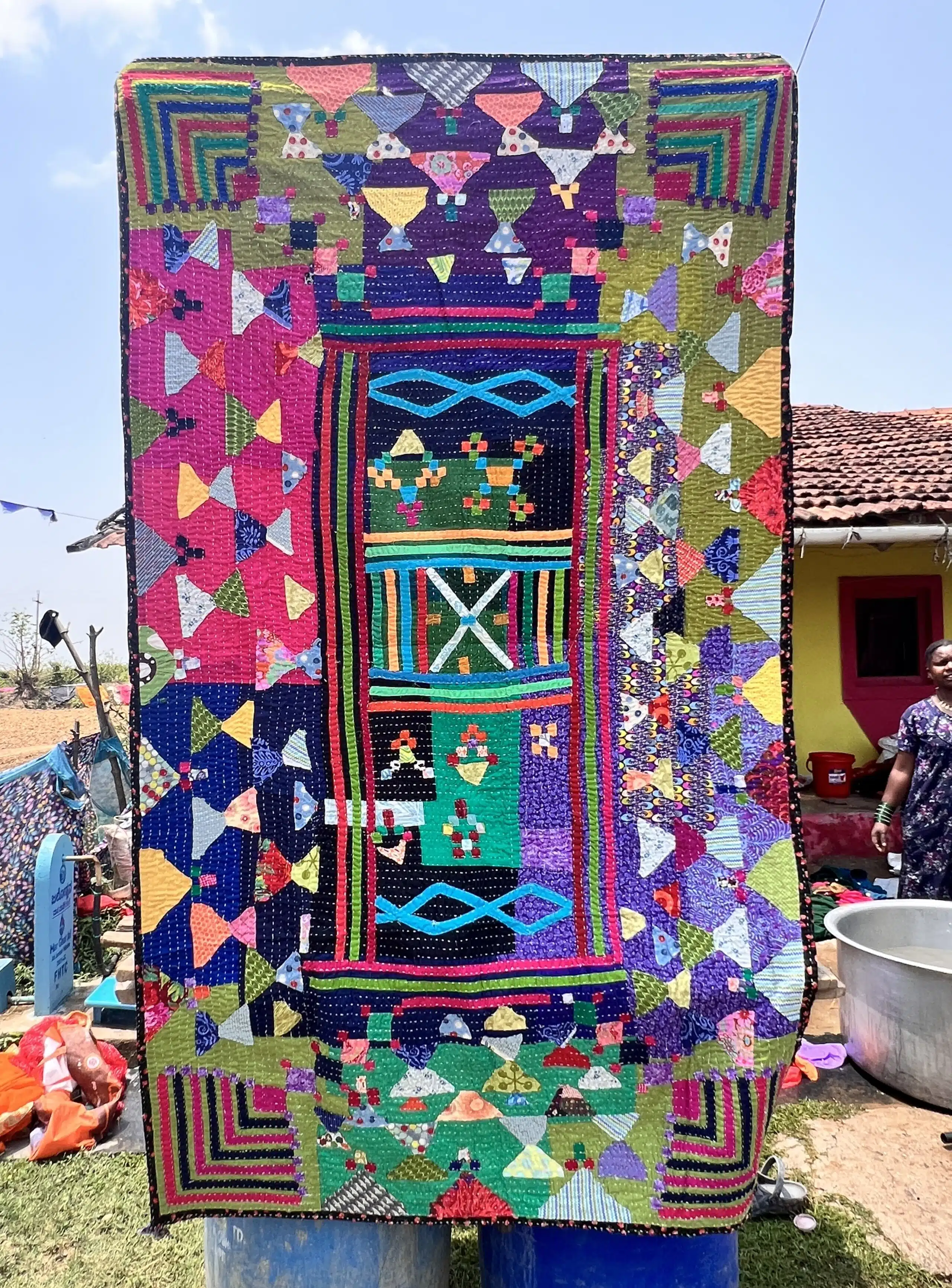
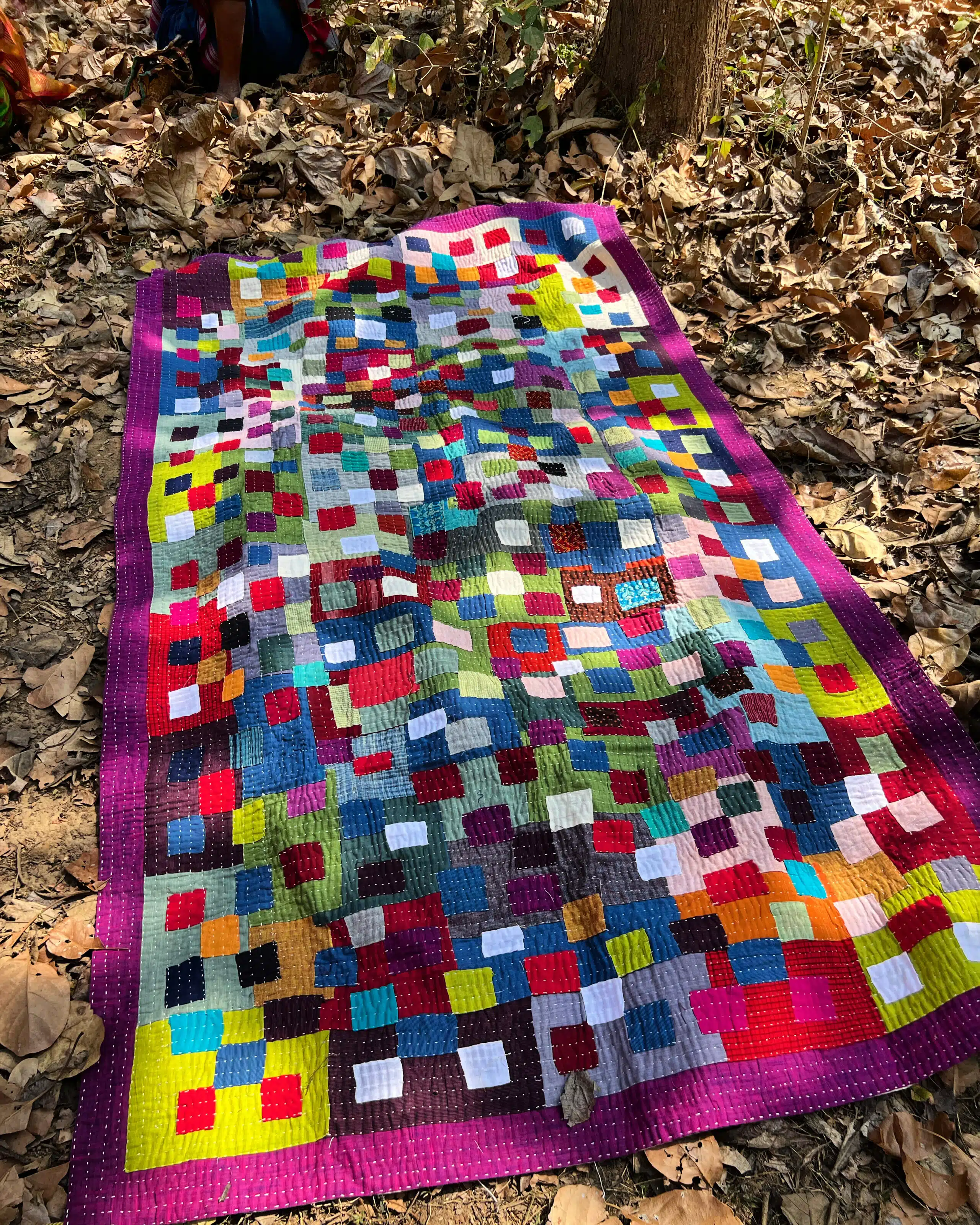
How do you see this work in relation to the larger art world?
This work, at its core, is deeply collaborative — rooted in community, expression and mutual understanding. It’s about working alongside the Siddi women, not just facilitating their craft but collectively holding space for their creativity, voices and lived experiences to emerge.
This platform I’ve helped create is not just about economic opportunity—though that can be a byproduct—but about recognizing women’s work as valuable in itself. It’s about undoing the historical and cultural silencing of women’s creative labor in their own community and in the larger world. My intervention, if we can call it that, simply adds another layer to a long-standing practice. It’s an effort to amplify their voices, their perspectives, and their aesthetics—not to alter or “develop” them. The quilts, in this sense, become both personal and political: acts of expression, survival and visibility by a community that has long been displaced and overlooked.
On our recent trip to Jodhpur as previously mentioned the women were exposed to new ideas, had the opportunity to engage in discourse and conversations and the residency offered them space to reflect on their own practices in relation to others. It is important that they have more such experiences. We are now working together to co-create a series of quilt panels that respond to their experiences of Jodhpur. These will be made using fabric scraps sourced from Jodhpur’s local markets, anchoring the quilts both materially and thematically in the city. These panels will then be exhibited in Jodhpur as part of the Jodhpur Art Week later this year.
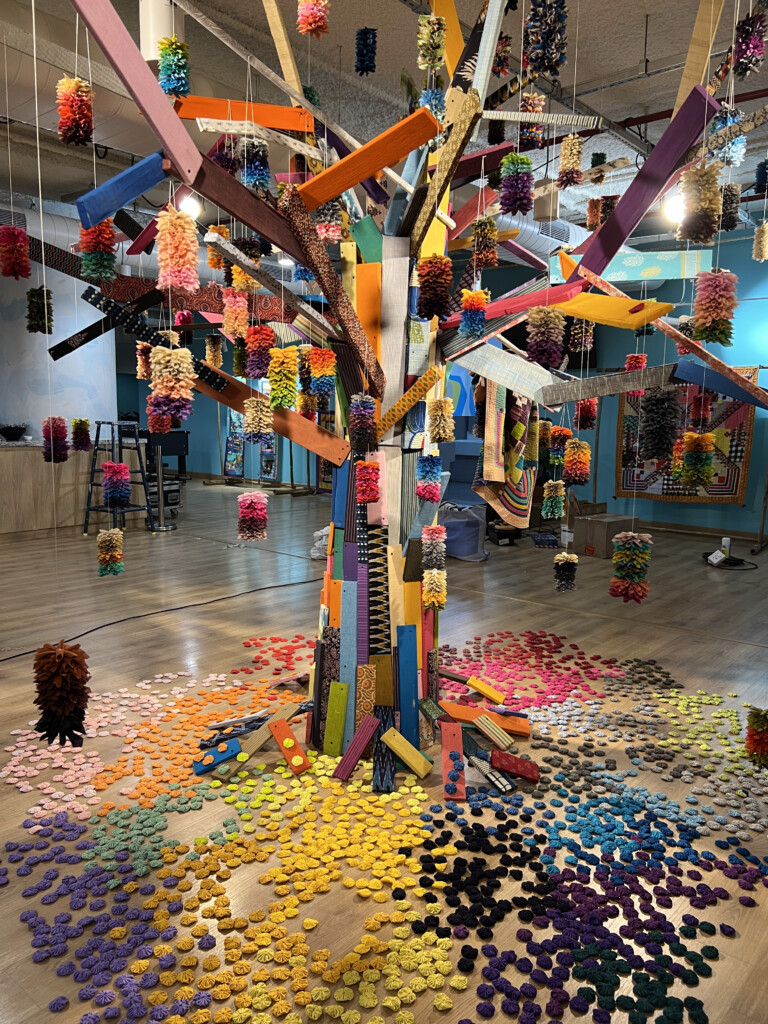
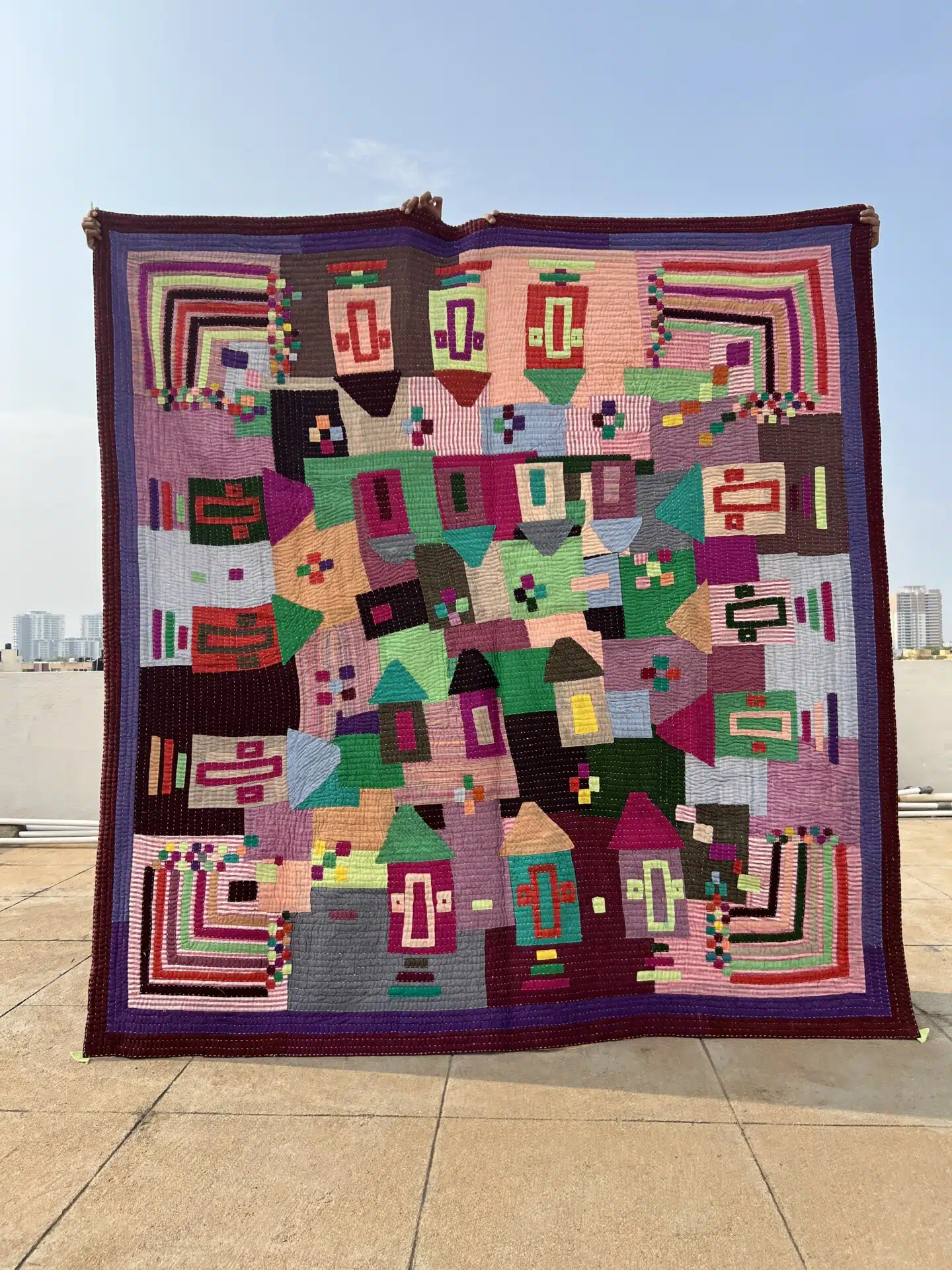
If contemporary art is about being in the present, reclaiming identity, memory and authorship — then there’s no doubt in my mind that the quilts belong in it. Too often, anything made in a rural or domestic setting gets called craft or folk art and never quite makes it as ‘art’ – that can be limiting, not just for the artists, but for the people engaging with the work too. The Siddi women’ s work is informed by their lived knowledge and is rooted in real-world issues that the community continues to witness and navigate on an everyday basis. When their quilts go into galleries, they aren’t just artefacts but authored works, born from artistic vision and created with agency, and that distinction matters.
What are some recent projects you’ve done together, and what’s ahead?

Apart from the Atlassian commission I mentioned and the work we’re doing towards the Jodhpur Art Week, we are working on a collaborative project with the Newark museum that explores ancestry, generational memory and the tensions between connection and disconnection across geographies—specifically with displaced, marginalized and discriminated communities. The women will travel with me internationally for the first time and be recognised as co-authors of the work. Engagements like these help build long-term, ethical platforms for socially-engaged art practices like mine and make space for community-based practices.
Both the women and I have been intentional in presenting work in art spaces, museums and galleries that nurture dialogue. We were recently part of a curated exhibition in Germany which focused on the global diaspora and invited audiences to engage with the context and complexity of these pieces.
The Siddi community has taught me to honour spontaneity, to value the unstructured, and to embrace uncertainty. So, while I can’t offer a fixed prediction about the direction of our work, I can say this: it is process-driven, rooted in the present moment and always open to transformation.
My hope is to continue working in ways that blur the lines between artists and artisans, educated and intuitive practices, between individual and community, between subject and object; creating space for voices that are too often overlooked and reframing what constitutes contemporary art.
Why does this work matter right now?
Because it insists on slowness, care, and acknowledging creative labour. Because it refuses the idea that art must come from a studio or be made in a certain environment. And because it creates room for artistic agency and vision to emerge from the most unlikely spaces.
Anitha Reddy is a Bangalore-based artist and facilitator working at the intersection of community, contemporary art, and cultural preservation. Her long-standing collaboration with the Siddi women of Karnataka is a social documentation or craft revival and a sustained community-centered artistic practice that redefines authorship, belonging, and creative labour.


